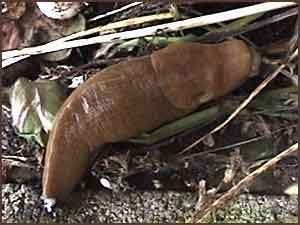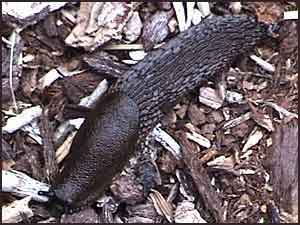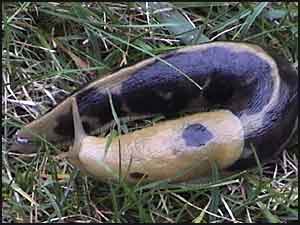Slugs
Banana Slug Video Clips

Because banana slugs are native, they are an important part of a balanced eco-system. They take care of keeping the forest floor clean of dead and dying debris. They decompose live and dead vegetation, consume roots, lichen, algae, fungi, carcasses and numerous other items recycling them into soil. It is said that their favorite food is mushrooms. Sometimes they eat garden plants, not excessively, just a nibble here and there. They are not the voracious eaters of garden plants like the non-native European Black Garden slugs.
Banana Slugs are the largest slugs in North America and the second largest slugs in the world. They are usually 6 to 8 inches in length, but sometimes they can grow to 12 inches.
European Black Garden Slugs

Don't confuse the European Black Garden slug with the banana slug. The garden slug is black, brown, or red in color. If you look closely at the garden slug, it has deeply textured furrows, ridges or grooves on all upper parts of the body except the mantle (the big hump just below the head). Typically, there is also an orange-stripe around the edge of the foot. The banana slug has neither the textured furrows on the upper parts of the body nor the orange edging around the foot.
Spotted Banana Slug

Ariolimax columbianus, the banana slug, was named in 1851 by Augustus Gould after the Columbia River district where the slug was first found. It is the only species that has color variations and can sometimes be spotted. This camouflage allows them to blend into the scenery. Lying next to a brown and black spotted leaf, the Spotted Banana slug blends like a chameleon.
Slug Predators
Some slug predators are snakes, shrews, moles, salamanders, beetles, crows, ducks, geese, toads, foxes and porcupines. Raccoons also prey on slugs, but they roll the slug in dirt to coat the slime before they eat them. Watch a video clip of a Red-striped Garter Snake dragging a Banana Slug into a shaded area and another video clip of the snake eating the slug.
Slug Anatomy
At Oregon State's Slug Anatomy 101, there is a black and white photo of a slug with labeled body parts and a short description. Slugs are interesting creatures. The genital opening and anus are located under the mantle, not near the tail as one would assume.
According to Pacific Natural History's site called Banana Slugs and European Black Slugs, both are members of the Class Gastropoda found in the Northwest United States. They travel on a muscular foot leaving a trail of slime, which serves several purposes. They have on a dorsal hump, a radula with 27,000 teeth-like structures, and a mantle with a cavity.
These two slugs belong to the Subclass Pulmonata due to their pnuemostones. A pnuemostone is an opening which leads to a small lung. This is one way which the slug can breathe. The pnuemostone is also used in excreting waste. The slug can also breathe through its skin so long as the skin remains moist for gas exchange to take place.
Waste is not expelled from the tail. The end of the tail contains a mucus plug. As the slug moves, slime moves any excess debris backwards forming a mass at the end of the tail. When the mass is large enough, the slug curls around and bites off the mass. Because they are recyclers, they often eat the debris.
Nature Park, a very informative site on slugs, discusses placing a slug on a piece of glass and looking at it from underneath. You can watch small horizontal waves of muscle move from the back to the front of the animal, allowing it to glide over a surface. A slug can travel over a razor blade or sharp edge of glass without cutting itself because of the slime that covers the foot.
Slugs have two pairs of tentacles and even though both are used to locate food sources, there is a difference in the function of each pair. The longer upper pair are where the eyes are located. These are optic tentacles. There is a small black tip at the end of each tentacle. They use these light-sensitive tentacles to gather information about their environment and also use them for smell. The second pair of tentacles are shorter and are located below the optic tentacles. They are sensory tentacles. They allow the slug to feel, taste and pick up chemical scent trails used during their mating seasons.
Slugs are hermaphrodites which means they have both male and female reproductive organs. In a wonderfully entertaining and humorous article called Slimes of Passion, banana slug penises have evolved to be almost as long as their bodies. Because they are hermaphrodites, each partner's penis must fit into the other's genital opening. Hence the importance of finding the same size banana for mating. Often the penis of the unstuck slug must be gnawed off in order to release the pair. This unique phenomenon is known as apophallation.
Their eggs, about the size of your pinky fingernail, are pearl-like in color. In early spring, late summer and early fall, eggs are laid in clusters of 12 to 100 underneath logs, rocks and in soil crevices. After laying the eggs, the adult usually dies.
Slime is produced from all parts of the body. The pedal gland produces a thick, sticky slime for movement. The foot produces a thin, watery slime that moves from the center to the edges of the foot and creates their slime trail. From the tailpit, they also produce a thin cord of slime used to lower themselves from a tree like a spider web.
Removing Slug Slime
If you ever have slug slime on your hands, don't try to wash it off because water increases the amount of slime. Instead, let the slime air dry, wave your hands in the air, and rub it off between your hands or with a paper towel. Dry Boraxo soap can also be used to remove it.
Save the Bananas
Because the banana slugs are native and provide a useful waste management purpose in our eco-system, save them. Although not voracious eaters of garden plants, if you see them munching on a garden plant, gently move them. They will find other food sources. If you must relocate them, take them to the forest where they can continue to do their clean-up job. Please don't kill Mother Nature's wonderful recycling creatures.
